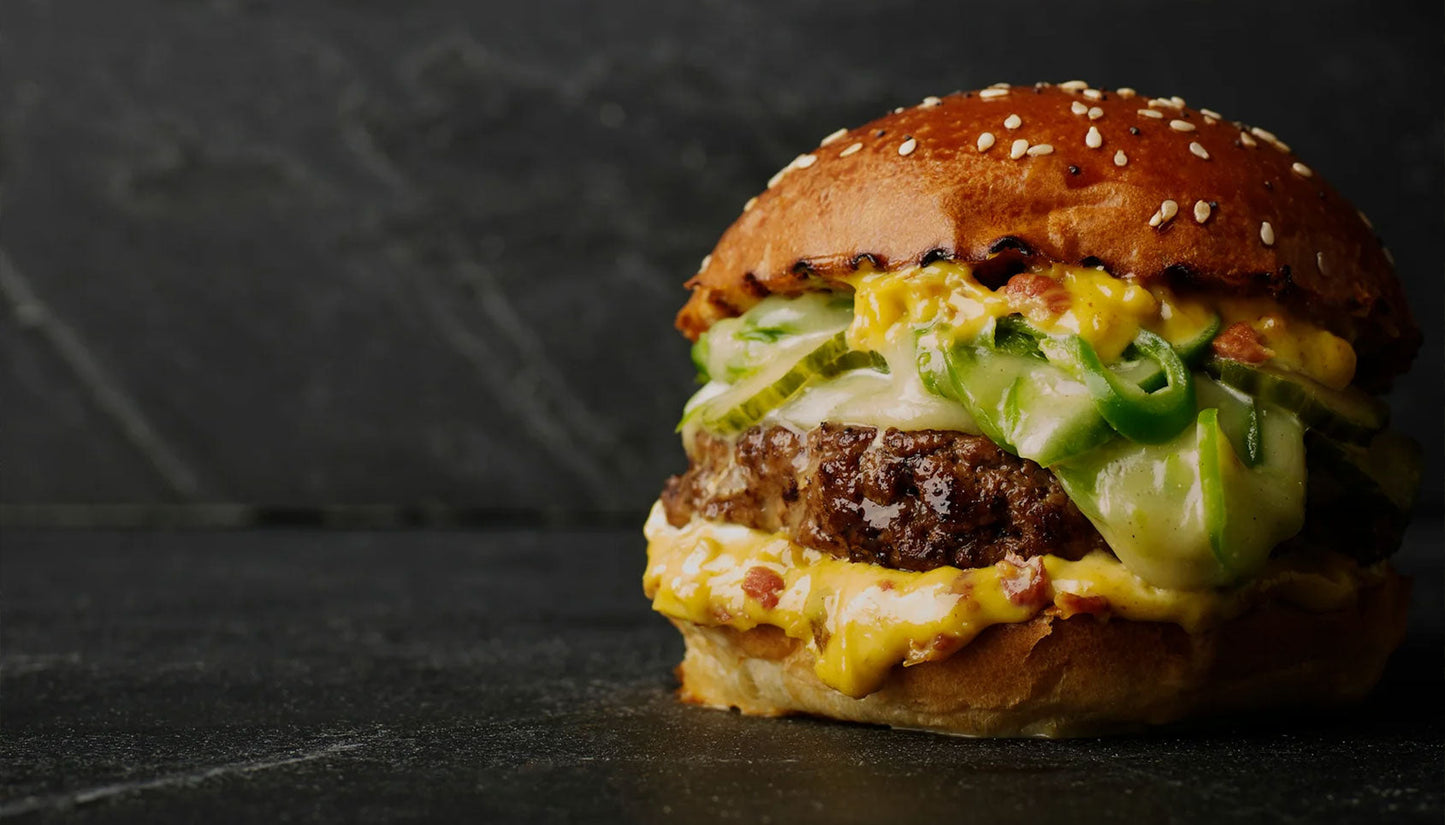We source our chicken from one farm in Leicestershire. The farm is Pasture for Life certified and rears truly free range, outdoor birds.

What's the true cost of our food?
Price is what we pay to obtain something but all too often the cost is greater, much greater.
What do we mean by this?
The term 'cost' refers to the expense incurred in the production of a product or service. The term 'price' refers to the payment required for the supply of a product or service. So how does this relate to our food?
If we are to look at meat products as a case in point, in this article we will consider the humble burger, that is to say, simply 100% ground beef shaped into a disk, and consider best versus worst case scenarios where we see a huge discrepancy between cost and price.
The corporate factor
When corporations act, they frequently do so as if they were a coldly rational being motivated exclusively by profit. In order to keep profits high large corporations often seek to keep costs as low as possible and this includes staff, raw materials and production methods leading to potential unaccountable negative impact to the environment, society or health, these factors in economics are termed 'externalities'.
Externalities are therefore costs that are not reflected in the price, these costs are costs such as emissions including carbon and the carbon footprint of production and when considering environmental costs.
Other externalities in the example of a burger using industrial meat are factors such as prophylactic antibiotic usage meaning that antibiotics are no longer effective for human use, pesticide run off, fertiliser run off and damage to waterways and controversially, the use of glyphosate to dessicate crops for harvest, all of these factors have a HUGE cost that is not factored in. One Chinese study from 2006 calculated that for every dollar spent on pesticide use the future cost to us of cleaning it up is a staggering 80 cents [1]
The cost of lost opportunity.
What we mean by lost opportunity in agriculture is the potential of the land to support biodiversity, harbour an ecosystem and sequester carbon through photosynthesis, this becomes a huge issue when we're assuming that an industrial or conventional system is currently used. If we're considering this in relation to industrially produced meats this list potential can be very high, especially so where crops are grown industrially to be fed to animals, not only are we losing a huge potential on the land, we're losing the potential of the animals to positively interact with an ecosystem as would happen with regenerative farming.
If we take the industrially produced beef burger as an example none of these 'externalities' costs are reflected in the 'drive through price' and yet they still have to be paid by someone, somewhere at some time.
According to a report back in 1994 by the Centre for Science and the Environment in India a burger grown on clear cut forest should really cost about $200! [2] - However, this study is from 1994 meaning the true cost today is many many times higher and very difficult to calculate but undeniable in its impact.
For more up to date and UK centric data the Sustainable Food Trust produced a report in 2017, updated in 2019 called The Hidden Cost of UK Food, available to download from their website here. As with everything they produce this very thorough and very well researched report.

The report states in the executive summary:
This report finds that the food we eat costs us almost twice as much as appears in our shopping bills. For every £1 UK consumers spend on food, additional costs of 97p are incurred. These costs are not paid by the food businesses, nor are they included within the retail price of food. Instead they are passed on to society in a range of hidden ways. In total, production-related costs account for an extra 48p for every £1 spent on food, while the costs of diet-related disease account for an extra 39p.
One surprising conclusion is that farm support payments account for only 2.5p in every hidden £1 spent on food.
Breakdown of every hidden £1 spent on food:
Breakdown of every hidden £1 spent on food:
- Natural capital degradation 31.1p
- Biodiversity loss 6.5p
- Production-related ill-health 8.8p
- Diet-related disease 37.4p
- Imported food 7.8p
- Farm support payments 2.4p
- Regulation and research 2.9p
Total £0.97
These costs are often also subject to subsidies making the true cost potentially even higher. The way this can happen as an example in the USA is that corn is the most subsidised crop, this crop is often fed to cattle in the finishing stage in a feedlot and this meat is commonly used for cheap burgers meaning that consumers are indirectly funding paying for cheap foods with their tax dollars on top of the externalities mentioned above. In 2006 a report from Tufts University made claims that the US Beef industry saves $562 million a year by finishing on subsidised corn, the figure today is likely to be much much higher.
True Cost Accounting.
What we pay for food in monetary terms does not reflect its value, its cost to the food system or a fair price to producers. Against this backdrop, the concept of true cost accounting (TCA) has been gaining traction in the food sector, having been adopted on a voluntary basis by many companies and organizations interested in promoting fairer prices, corporate social responsibility and environmentally sustainable practices.
The new corporations
We mentioned above how corporations traditionally are purely profit seeking enterprises which can lead to a lack of awareness of true cost factors but is this changing, we think so.
Certifications such as B-Corp offer businesses a framework to operate in ways that benefit more than shareholders and hold values that go beyond simply making money.
B Corp Certification is a designation that a business is meeting high standards of verified performance, accountability, and transparency on factors from employee benefits and charitable giving to supply chain practices and input materials. In order to achieve certification, a company must:
Demonstrate high social and environmental performance by achieving a B Impact Assessment score of 80 or above and passing our risk review. Multinational corporations must also meet baseline requirement standards.
Make a legal commitment by changing their corporate governance structure to be accountable to all stakeholders, not just shareholders, and achieve benefit corporation status if available in their jurisdiction.
Exhibit transparency by allowing information about their performance measured against B Lab’s standards to be publicly available on their B Corp profile on B Lab’s website.
Above in Italics take from B-Corp website
This in turn is driven by a new wave of purpose driven consumer who has the freedom to choose which businesses to support and is savvy of the rampant greenwashing of larger corporations.
In the context of a burger, who's doing the right thing?
A little while ago we announced our collaboration with Honest Burger as they started to shift their beef to to come from a regenerative supply chain by sourcing through Grassroots Farmers collective.
Grassroots are measuring their regeneration on a farm by farm basis, each farm sets their own specific regenerative objectives. These span regenerating their soil health, carbon balance, biodiversity and community.
Rather than being told what they must and must not do, each Grassroots farm selects from a toolbox the regenerative techniques that will work in their natural environment. This also means they can focus on the changes that will have the biggest benefit.
This is an example of a corporation putting ethics ahead of short term profit and taking responsibility for the true cost.

At Honest Burger a burger with fries costs £10 whereas the same can be had from one of the bigger well known chains for as little as £3.
we know which ones is cheapest but which burger is the lowest cost, we'd say that the Honest Burger is the lowest cost by a substantial margin.
Should regeneratively produced food be subsidised?
We've discussed above why we consider that there is actually no such thing as cheap food as true cost accounting is not considered, if it were surely it would make more sense to subsidise foods that are grown regeneratively rather than destructive? Imagine a world where the regenerative 100% pasture raised, hormone and antibiotic free burger is subsidised by government schemes to retail at £5 and the industrial concentrated corn fed feedlot burger is £20, this makes more sense to us than the current situation.
We're looking forward to a world where doing the right things is rewarded so that we do not have to pay for destruction further down the line.
[1]. Weiqi Chan et al., Estimation of of environmental cost incurred by pesticide application in coastal agricultural region management measures - Environmental Informatics Archives 4 (2006)
[2]. Nancy Dunne - "Why a hamburger should cost 200 dollars - The call for prices to reflect ecological factors'' - Financial Times January 12th 1994
This article was heavily inspired by these two books. Both make great reading around this subject and are highly recommended.
Sitopia - How food can save the world - Carolyn Steel
The Value of Nothing - Raj Patel





